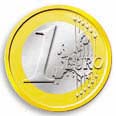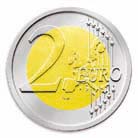All That Glitters is Mostly Copper - Part 2
Copper Applications in General Interest Area
All That Glitters is Mostly Copper - Part 1
Innovative Metallurgical Development
There's an interesting and even somewhat dramatic history behind the metallurgy of the Golden Dollar. And, in an age when we've become accustomed to high-tech breakthroughs such as ultrahigh-speed computer chips based on copper (see Speeding-up Your Computer in the 21st Century Using Copper ICs), it's nice to learn that new copper alloy development also benefits such prosaic uses as the coins in our pockets.
In April 1999, the Mint brought together major stakeholders with interests in what would become the new dollar coin. Participants in the meeting included vending machine suppliers, coin-acceptance equipment manufacturers and the supplier of the sandwiched alloy strip from which the coin would be minted. As the Mint's Barry Claybrook, Dollar Coin Program Manager—Operations recalls, "We had a mandate from Congress that specified the color and physical attributes of the dollar. The Stakeholders would have to deal with those attributes, which might affect their businesses.
"What we did was something completely new to the Mint," says Claybrook. "We directly involved representatives from potentially affected industries—the stakeholders—in our decision-making process. Ordinarily, the Mint would simply have designed the coin on its own. This time, we were faced with a special situation because the new coin would have to be completely interchangeable with the existing Susan B. Anthony dollar, of which there are now hundreds of millions in circulation. The approach was successful: we received very valuable input and cooperation from the stakeholders, and everyone benefited."
The task of designing the composition of the dollar fell to Dennis Brauer, a metallurgist and vice president of Quality and Product Development at Olin Brass, East Alton, Illinois. Olin Brass is a leading U.S. copper alloy producer and has for many years been an approved supplier of coinage strip to the Mint. Olin is also one of the few American companies that continues to develop new copper-base alloys. (There are others, but none that also produces coinage strip.)
Brauer knew he faced a difficult metallurgical task. "Our objective was to mimic as closely as possible the electromagnetic footprint and the weight of the Susan B. Anthony dollar while at the same time giving the coin a golden color. Any one of those parameters are relatively easy to satisfy; the really hard part is getting all three correct at the same time."
"The combination of electromagnetic footprint—in particular, the coin's electrical conductivity—and color was the most difficult objective to achieve. The Mint's specifications called for a color between that of 14 and 22-karat gold. We knew the electromagnetic footprint of the SBA, and from the technical literature and our extensive experience with copper alloys, we knew something about what effect various alloying elements would have on these parameters.
"We recognized that we had to select alloying elements that reduce copper's conductivity. All elements do that, but only nickel and manganese will remain in solid solution in copper over the range of concentrations of interest in a coin. Staying in solution (i.e., not precipitating as a separate phase) is critically important because precipitation would change the alloy's electromagnetic properties.
"Copper alloys containing nickel (like those in other U.S. coins) are silvery in color, so nickel alone wouldn't work. Copper-manganese alloys, of which there aren't very many, retain more of copper's red color. There is, for example, a copper alloy called manganin, which contains 87% copper and 13% manganese, that is used in electrical resistors and some thermocouples. It has high electrical resistivity (low conductivity) and is somewhat pinkish in color. We discovered that by using a combination nickel and manganese we were able to get very close to the conductivity required in the new dollar.
"We also knew that zinc imparts a yellow color to copper alloys, as it does in brasses. Our alloy development approach, therefore, was to combine copper with manganese, nickel and zinc to simultaneously satisfy all the required properties. We tested many compositions before we arrived at the combination of 77% copper, 12% zinc, 7% manganese and 4% nickel that the Mint accepted." Metallurgically, the new alloy would be classified as an example of what are called manganese brasses. The brass is a single-phase alpha alloy like, for example, ordinary cartridge brass. The alloy is metallurgically stable, and micrographic examination reveals no evidence of precipitation. In addition to having the specified electromagnetic properties and the proper color, the alloy's density, 0.312 lb/in³, is very close to that of the copper-nickel it replaces.
The new alloy also has many of the other properties one would like to see in a coinage material. Its high malleability enables it to be embossed to produce clear, sharp images. It is durable, yet not so hard as to generate excessive wear in stamping dies. Like other copper alloys, it is also tarnish and corrosion resistant, and it has a pleasant ring when struck.
The new dollar will be the first coin in the world to contain a manganese brass, and Olin Brass can be justifiably proud of its historic accomplishment. Having developed the alloy, Olin Brass will supply the Mint with clad strip from which many of the new Golden Dollars will be struck. PMX Industries, Cedar Rapids, Iowa, the Mint's second material supplier, will also furnish strip for the new coin.
Copper-base Coins Worldwide
The Golden Dollar is certainly the most exciting event on the U.S. numismatic stage, but it actually continues a tradition of copper coinage that had its origins in antiquity. Copper and bronze coins were used in the Roman Era and forms of copper ingots were used as currency centuries earlier. It is a testament to the metal's durability that many ancient copper coins, still fully intact, have been found in shipwrecks more than 1,500 years old.
It is no wonder then, that copper and its alloys continue to be selected for modern coinage throughout the world. Nations like Canada, England, France, Italy, Germany, Mexico, Chile, Spain, China, Japan, Australia and New Zealand, among many others, have long relied on copper alloys for most of their coin denominations. Copper-nickel and aluminum bronzes (alloys of copper and aluminum) are the most widely used compositions, alone or as cladding, but nickel-aluminum bronzes, nickel-aluminum-tin bronzes and even brass coins are produced around the world today. Some new Scandinavian coins will be struck in Nordic Gold, an alloy of 89% copper, 5% aluminum, 5% zinc and 1% tin developed by Outokumpu Copper of Sweden.


The next important examples of new copper currency will appear in Europe in 2002 when the euro family of coins is issued. Like the current English 2-pound piece, the 1- and 2-euro coins will be bimetallic, that is, they will have a bullseye-like appearance with an outer ring of one alloy (and color) surrounding a central region of another composition. The 1-euro coin will have an outer ring of 75% copper, 20% zinc and 5% nickel (a golden color); the center will be 75% copper/25% nickel (silvery) clad over nickel. The 2-euro coin will have the opposite color scheme with an outer ring of 75% copper/25% nickel surrounding a center having the 2-euro's golden alloy clad over nickel. Dollars of all nationalities, pounds, francs, marks, pesos, pesetas, rials, lira, zlote, lita, yen, yuan and soon, euros benefit from the unique properties offered by copper alloys.
Who says copper is a nonprecious metal?
Also in this Issue:
- Honda Insight Relies on Copper
- CuproBraze® Copper/Brass Radiators in Production
- All That Glitters is Mostly Copper - Part 2
- All That Glitters is Mostly Copper - Part 1
